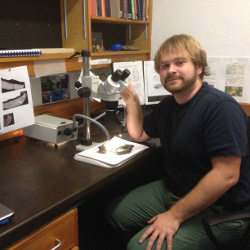
Fossil Focus: The ecology and evolution of the Lepospondyli
by Aodhán O'Gogain*1
Introduction and background
During the Pennsylvanian subperiod (roughly 318 million to 299 million years ago), lush tropical rainforests covered much of what is now North America and Europe, but were then near Earth’s Equator. These tropical forests were teeming with animals, from 2-metre-long millipedes that scurried along among the roots to fish with fangs 10 centimetres in length that inhabited the associated rivers and estuaries. Living among these giants was a diverse group of small (less than 1 metre) vertebrates that resembled newts, lizards and snakes. These were the Lepospondyli, a sub-class of tetrapods that are characterized by having hourglass-shaped centrums, the central parts of their vertebrae. They had elongated, small bodies and short limbs, with one...
